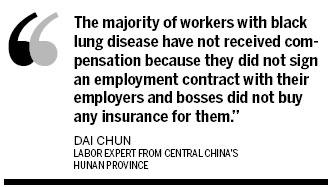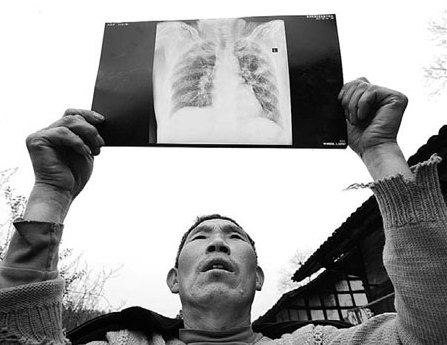Black lung patients often face a long wait for compensation
Updated: 2013-03-25 07:58
By Chen Xin and He Dan (China Daily)
|
||||||||
|
A black lung patient from Tongren, Guizhou province, looks at an X-ray of his lungs. Provided to China Daily |

Legal process to make claim may take up to 3 years to complete
Zhao Wenhai spends most of his time sitting in bed, even during the middle of the night, because he is afraid lying down will kill him.
Zhao, 43, was diagnosed with third-stage black lung disease, the highest severity of the illness, in 2007 after he spent six years toiling at a small gold mine in Northwest China's Gansu province between 1998 and 2003.
Zhao became a taxi driver in his native Gulang county in Gansu after he left the mine in 2003. He developed a bad cough the same year.
He lost the ability to work in 2010.
Black lung, or pneumoconiosis, has a high fatality rate.
"I think I cannot hold on until next year," he said.
Zhao still has hope for a "big" compensation settlement.
Zhao's compensation from a public work injury insurance fund has been delayed for eight months.
Zhao lives on a monthly 900-yuan ($145) subsidy from the government and some 700 yuan that his wife, a disabled woman, earns each month by making crafts.
Due to the lack of other sources of income, the couple have to borrow money to pay the tuition fees of their two children.
"Sometimes I feel breathless and hopeless," he said.
Similar fate
As of the end of 2010, some 676,000 cases of pneumoconiosis had been reported and 22 percent of those patients have died, according to the health authority.
The actual number of patients could be closer to 6 million because a large number of workers in small factories are not under the health authority's occupational disease supervision, according to NGOs, labor experts and lawyers who attended a seminar in Beijing last month.
Liu Jianwei, 41, has a bad cough. Last year, he was diagnosed with first-stage black lung disease after working at a gemstone factory in Beijing for 15 years.
Liu spent the past six years fighting to protect his rights and helped 25 black lung patients who worked at the same factory, including his wife, get compensation from the employer or work injury insurance fund.
Workers diagnosed with first-stage pneumoconiosis received one-off compensation of some 160,000 yuan. Others who had more severe complications from the disease received a one-time compensation of 50,000 yuan and were eligible for a 2,000-yuan subsidy every month and full reimbursement of their medical expenses.
Liu is still waiting for a settlement from a court about his compensation.
Current laws require companies to provide work injury insurance for employees and ensure the country's work injury insurance fund covers treatment fees and compensation to those with occupational diseases - as long as the employee's company paid for the insurance.
An injured worker could receive compensation equal to 7 to 27 months of his monthly salary based on the severity of the injury or disease.
If the employer did not pay for the insurance, it should be responsible for all fees.
Hard battle
Liu Jianwei said the gemstone factory provided work injury insurance for some workers in order to cope with local social security authority's supervision and checks.
Liu said the employer dismissed all sick employees in 2009 and that had made workers' compensation payments difficult to make.
Workers should provide documentation, including proof of employment, results from health checks and workplace risk evaluations, before they can apply for an occupational disease diagnosis, said Ye Mingxin, an expert with the Beijing Yilian Legal Aid and Study Center of Labor, a non-government organization.
Currently, people claiming to have a work-related disease must follow a medical and legal process, including the occupational disease diagnosis, which takes, on average, at least three years to complete, she said.
It is only after the process is completed that patients can access compensation payments.
"Many employers refuse to hand those documents over, and in many small factories, employers do not keep workers' health records or conduct workplace risk evaluations," she said.
As a result, the process takes a long time, and the treatment for many patients is delayed, she added.
Only 10 percent of employees in China receive regular occupational health services, said Yu Wenlan, a health expert with the Chinese Center for Disease Control and Prevention.
"Based on my field studies in Hunan, Sichuan and some other provinces, the majority of workers with black lung disease have not received compensation because they did not sign an employment contract with their employers and bosses did not buy any insurance for them," said Dai Chun, a labor expert from Central China's Hunan province.
Dai said some local social security authorities lack the motivation to extend work-related injury insurance coverage, which in some ways fosters the malpractice of employers.
"I've learned that some social security departments are worried that they may lose profit in the work injury insurance fund if companies with a high rate of work-related injury incidents pay the insurance for their employees," she said.
Way out
Chen Jingyu, a deputy to the National People's Congress, China's top legislature, submitted a motion to the legislative body urging medical aid for black lung patients during the annual session of the NPC earlier this month. His proposal was signed by 30 other deputies.
Chen, who is also deputy head of the Wuxi People's Hospital in Jiangsu province, said he has seen too many workers stricken by black lung traveling thousands of kilometers, using money they borrowed, in search of a cure.
Chen said he expects the government will give more attention to the plight of workers with black lung disease and take action to help them.
"Our motion calls on the health authority to include black lung disease into the public medical insurance system for residents and ensure that patients can receive reimbursement of at least 70 percent of their medical expenses," he said.
Such measures should be targeted at sick workers who cannot find their former employers or provide employment records, he added.
He also proposed the government provide monthly subsidies for black lung patients since they lose the ability to work and often fall into poverty after they contract the disease.
"Not only do miners run a high risk of contracting the disease. Traffic policemen, workers in gemstone factories and others exposed to dust all face such risk," he said.
"Precautions are important. I hope the government will tighten its supervision on employers so that a safer working environment can be created for workers," he said.
A regulation released by the Ministry of Human Resources and Social Security in 2011 requires its nationwide grassroots bureaus to use the work injury insurance fund to pay workers' medical expenses if their employers did not provide workers' insurance coverage and refused to take responsibility for treatment fees.
Then bureaus can order employers to pay those fees, according to the regulation.
Tang Chun, an expert with China Occupational Safety and Health Association, said farmers-turned-migrant-workers are most vulnerable to occupational diseases such as black lung.
Nearly 29 percent of the 250 million migrant workers in China had work injury insurance by the end of last year, according to the Ministry of Human Resources and Social Security.
"Greater efforts should be made to ensure wider coverage of workers by the insurance," he said.
At the same time, some NGOs are taking action to help black lung patients.
The Pneumoconiosis Assistance Foundation, founded in 2011, has raised more than 6.2 million yuan to cure 608 patients.
Contact the writers at chenxin1@chinadaily.com.cn and hedan@chinadaily.com.cn.
(China Daily 03/25/2013 page4)

 In Photos: 7.0-magnitude quake hits Sichuan
In Photos: 7.0-magnitude quake hits Sichuan
 Li Na on Time cover, makes influential 100 list
Li Na on Time cover, makes influential 100 list
 FBI releases photos of 2 Boston bombings suspects
FBI releases photos of 2 Boston bombings suspects
 World's wackiest hairstyles
World's wackiest hairstyles
 Sandstorms strike Northwest China
Sandstorms strike Northwest China
 Never-seen photos of Madonna on display
Never-seen photos of Madonna on display
 H7N9 outbreak linked to waterfowl migration
H7N9 outbreak linked to waterfowl migration
 Dozens feared dead in Texas plant blast
Dozens feared dead in Texas plant blast
Most Viewed
Editor's Picks

|

|

|

|

|

|
Today's Top News
Live report: 7.0-magnitude quake hits Sichuan, heavy casualties feared
Boston suspect cornered on boat
Cross-talk artist helps to spread the word
'Green' awareness levels drop in Beijing
Palace Museum spruces up
First couple on Time's list of most influential
H7N9 flu transmission studied
Trading channels 'need to broaden'
US Weekly

|

|








